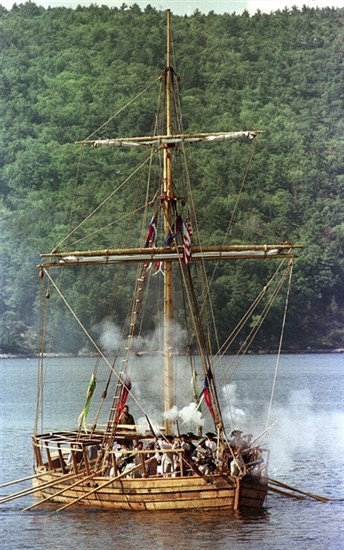
FILE - In this Aug. 18, 1991 file photo, a replica of the Revolutionary War gunboat, the Philadelphia, fires guns during its launch on Lake Champlain in Vermont. A similar gunboat, the Spitfire, has been on the bottom of the lake since it was sunk in 1776 during the Revolutionary War, while being used by Benedict Arnold to help hold off the British in the key naval Battle of Valcour Island. Historian Art Cohn is developing a management plan for the future of the Spitfire, fearing the possible threat of an invasive species that could destroy the wreck if it is not raised and preserved.
Image Credit: AP Photo/Craig Line, File
March 15, 2015 - 8:25 AM
MONTPELIER, Vt. - When it was built late in 1776 the gunboat Spitfire wasn't meant to be the pride of the American fleet. It was built to fight and fight it did, helping slow down the larger British fleet that sailed south out of Canada onto Lake Champlain as part of an effort to crush the colonial rebellion.
The 54-foot Spitfire sank a day after the critical Oct. 11 Battle of Valcour Island, settling into deep water where it went unseen for more than 200 years.
Now the historian who led the search that found the Spitfire nearly two decades ago is developing a management plan for the future of the boat that today sits on the lake bottom, its mast upright and its bow cannon pointing straight ahead, just as it was when it was abandoned by its crew.
"This is not a sexy boat," said Art Cohn, the emeritus director of the Lake Champlain Maritime Museum who is now writing a management plan for the Spitfire that he will submit to the U.S. Navy. "It was relatively small, flat-bottomed and quickly built, but that's not its value."
"The principal value, in my opinion, is it connects us to 1776 and the formative years of this country," he said.
For years, the bottom — Cohn won't say exactly where the Spitfire rests or how far down — has been thought of as the safest place for the Spitfire, thanks to the protection of the cold, deep water above it. Now the fear is of a looming threat from the invasive species quagga mussels, which could destroy the wreck. They haven't arrived yet in Lake Champlain, but experts fear it's only a matter of time.
Cohn's plan will include recommendations for the future of the Spitfire, including possibly leaving it where it is or raising it, preserving it and then displaying it in a museum. He hasn't chosen a course yet, but his worry over the mussels is clear.
"Our concern over the length of this study has really been elevated based on what we're learning about the implications of the mussel invasion. That information is sobering and a concern," Cohn said. "As we move toward final recommendations our goal is to try to develop a strategy so that this shipwreck survives for future generations."
The 50-man Spitfire was part of a small fleet that was assembled in the late summer of 1776 by Benedict Arnold before he turned traitor. The fleet was built at Skenesborough — now Whitehall, New York — to counter the larger British fleet being built on the Richelieu River in Quebec.
The British commanders intended to sail down the lake as part of a broader campaign to split New England from the rest of the fledgling United States of America and end the rebellion. Arnold anchored his fleet on the western side of Valcour Island, just south of Plattsburgh, New York, forcing the larger British force to attack him in the narrow confines between the island and the shore.
By all accounts the battle was a British victory. In the dark of night after a day of heavy fighting, Arnold famously slipped his remaining fleet through the British lines and retreated south. It was during that retreat that the Spitfire, leaking badly, was abandoned and sank, not to be seen again until 1997.
Even though the British won the day, the battle delayed their advance down the lake until 1777, giving the Americans much-needed time to prepare for the assault, ultimately leading to the American victory at Saratoga. That battle led to French recognition of the new country, key to the eventual defeat of the British.
Paul Taylor, a spokesman for the Navy's Naval History and Heritage Command, said the organization was looking forward to receiving Cohn's management proposal.
The usual preference is to leave vessels, especially in cold, fresh water, on the bottom where they will be preserved. Taylor said he was unaware of the mussel threat, but the Navy agrees with the need to protect its historic resources.
"We take preserving the history of our Navy very seriously," Taylor said. "The history of the Navy is the history of the nation."
News from © The Associated Press, 2015